Architectural Marvels of the UAE: A Towering Insight
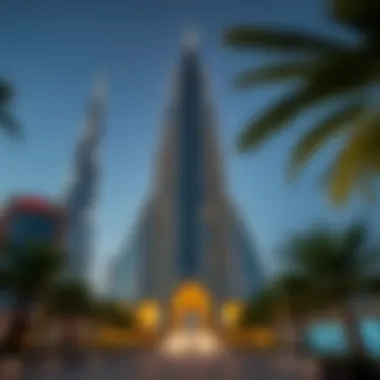
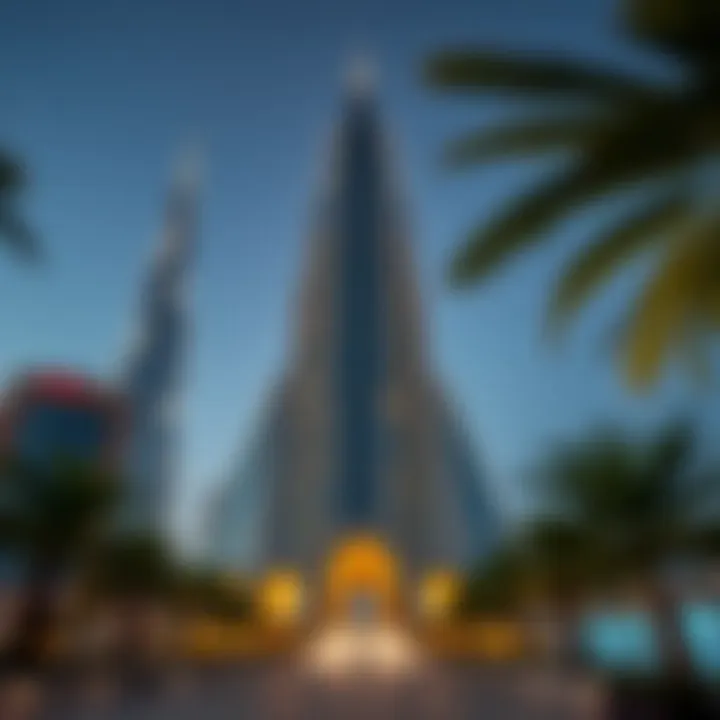
Market Insights
The architectural landscape of the UAE is nothing short of spectacular, with its towers symbolizing growth, innovation, and a bold vision for the future. As the economy continues to thrive, the real estate market in Dubai is a vivid reflection of what's happening globally as well.
Current trends indicate that luxury properties and high-rise developments are experiencing rising demand. Investors, both domestic and international, are keen on acquiring prime real estate in areas that offer not only stunning skylines but also unique lifestyles. High-profile developments like the Burj Khalifa and the Marina 101 attract significant attention, while newer projects like the Dubai Creek Tower are poised to alter perceptions yet again.
- Luxury Living Resurgence: An increase in affluent clientele is pushing developers to create high-end residential spaces, amplifying the competition within the market.
- Sustainability Focus: More towers are implementing eco-friendly technologies, emphasizing energy efficiency and sustainability practices—this resonates well with the informed buyer's preferences today.
- Mixed-use Developments: There’s a growing trend toward integrating commercial, residential, and recreational spaces. Developments that offer such versatility are not only appealing to investors but also cater to lifestyle needs of residents.
The integration of technology within these towers, from smart home features to energy-efficient systems, signals a substantial shift in how urban living is envisaged in the UAE.
Current Trends in Dubai Real Estate
As of late 2023, several trends are conspicuously shaping the Dubai real estate market:
- Increased Foreign Investment: Streamlined regulations have made it easier for international buyers, leading to a notable influx of capital.
- Rental Yields: Investors are increasingly attracted to properties that promise high rental returns. Areas surrounding iconic towers often see higher yields due to consistent demand from long-term tenants and tourists alike.
- Technology-Driven Sales: Online platforms, VR tours of properties, and 3D architectural models are changing how buyers and sellers interact, fostering instant connectivity.
Analysis of Future Predictions
The forecasts for the UAE real estate market showcase a bullish outlook:
- Continued demand for upscale housing is expected to sustain, especially in the midst of Expo 2020's legacy contributing to urban expansion.
- With increasing regulations to support property values, the long-term stability of the market appears promising.
- Projects like the Mohammed Bin Rashid City will likely reshape coastal living.
Real estate experts suggest that as urbanization persists, investment in UAE towers will not only provide tangible returns but will create an inspiring blend of lifestyle and luxury that appeals universally.
Investment Strategies
Navigating the UAE real estate landscape can be complex, yet understanding the fundamental strategies can lead to rewarding results for both seasoned investors and newcomers.
Tips for First-Time Investors
- Research Market Landscapes: Familiarize yourself with neighborhoods and tower specifications. Understanding the current market conditions will guide your choices.
- Evaluate Legal Frameworks: Ensure compliance with local laws, including ownership rights and property regulations, which can differ drastically across emirates.
- Leverage Local Expertise: Collaborating with local real estate agents or investment firms will provide invaluable insights into the best investment opportunities available.
Understanding Property Valuation
Valuation in this vibrant market takes multiple factors into account:
- Location: Proximity to key landmarks, ease of transport, and community amenities.
- Building Quality: Construction materials, architectural design, and historical significance, especially for heritage sites.
- Market Trends: Keeping abreast of fluctuations in supply and demand is crucial as they influence overall property prices.
In summary, comprehending the intertwining dynamics of architectural significance and real estate strategies in the UAE will equip investors and homebuyers with the knowledge necessary to make informed decisions. With the current and future landscape shaping up as a unique convergence of culture, technology, and lifestyle, the towering structures in this region tell a story of ambition and transformation.
Prolusion to UAE Towers
The topic of UAE Towers serves as a fascinating entry point into the architectural innovations that define this region. Towers are not simply tall buildings in the UAE; they are a reflection of the country's ambitious spirit and an embodiment of its rapid growth and development. As remarkable constructions that grace the skyline, they symbolize economic vitality and cultural progression.
The importance of this section lies in its ability to illustrate the evolution of tower architecture in the UAE. This evolution tells a broader story of the country's inventive mindset, international influences, and adaptability in facing diverse architectural challenges. For investors, homebuyers, and property managers, understanding this historical and architectural context is crucial, as it lends depth to their decisions in the competitive real estate landscape.
Diving deeper, the historical context of these structures paints a vivid picture of the transitions from traditional building styles to contemporary designs, revealing how the societal shifts and urbanization reshaped the possibilities of architecture in the UAE. Likewise, architectural styles cover a wide spectrum, showcasing groundbreaking designs that have become iconic landmarks, imbuing the towers with cultural significance and aesthetic appeal.
In summary, exploring these aspects of UAE Towers allows stakeholders to appreciate not just the buildings themselves but also the stories they embody. With this understanding, the rest of the article unveils a more comprehensive picture of the significance and impact these towers have within urban development.
Significance of Skyscrapers in Urban Development
The skyline is a city’s signature; it tells a story of ambition, vision, and transformation. In the case of the United Arab Emirates, particularly its flagship city Dubai, skyscrapers play a crucial role not just as architectural wonders but as key players in urban development. These towering structures symbolize the rapid growth and modernization of the region, reshaping the urban landscape and influencing various sectors in profound ways.
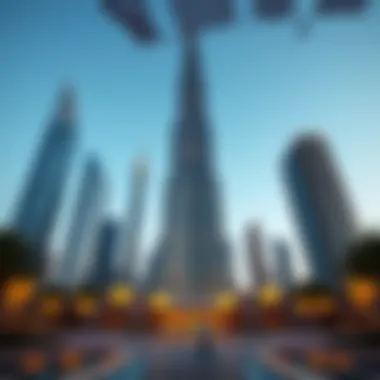
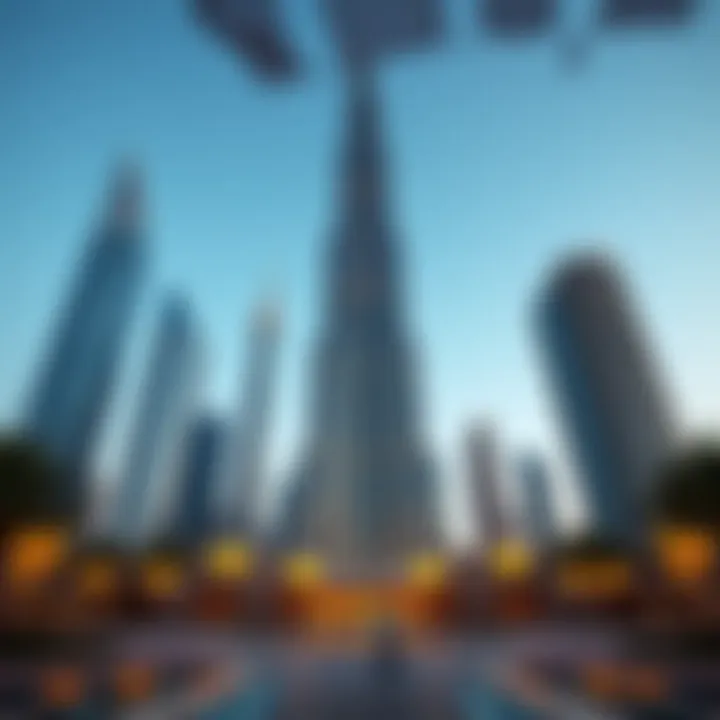
Economic Impact
Skyscrapers are not merely beautiful to behold; they serve several economic purposes that bolster the city’s economy. First off, these tall buildings house significant amounts of commercial space, which can yield high returns on investments. For instance,
- Investment Attraction: Foreign investors have a keen eye for the UAE's skyscrapers. The unique architectural design and premium facilities attract businesses and high-net-worth individuals alike. Consequently, this influx brings in capital and creates job opportunities for the local workforce.
- Tourism: Towers such as the Burj Khalifa not only entice visitors with their design but also stimulate various local economies. The money spent by tourists on accommodations, food, and entertainment substantially boosts the economy. Interestingly, Burj Khalifa's observation deck alone has become a must-visit site, creating a dedicated revenue stream.
- Infrastructure Development: The construction of skyscrapers often leads to improved infrastructure. Roads, transportation, and public services tend to receive upgrades, benefiting both residents and businesses. Enhanced public transportation links, including the Dubai Metro, facilitate easier access to these commercial hubs, further supporting economic growth.
The symbiotic relationship between skyscrapers and economic development illustrates a broader trend; as these buildings assert their presence on the skyline, they bring with them a plethora of economic opportunities.
Cultural Symbolism
Skyscrapers in the UAE do more than just dominate the skyline; they embody cultural values and aspirations. To locals and visitors alike, these towering structures represent a blend of tradition and modernity.
- Cultural Identity: Buildings like the Burj Al Arab reflect the UAE’s rich heritage while embracing contemporary design techniques. The sail-shaped silhouette evokes a sense of pride, as it connects the nation’s maritime history with its future aspirations.
- Global Stage: UAE towers, particularly those in Dubai, have positioned the region as a hub of innovation and luxury on a global scale. This is not just about height; it’s a statement. Cities across the world look to Dubai, studying its architectural trends and infrastructure developments, thereby cementing the Emirate's influence in shaping architectural aesthetics and urban planning.
- Social Interaction: Skyscrapers often become social spaces where cultural events, exhibitions, and gatherings occur. They facilitate community interaction, drawing individuals from different backgrounds together, fostering a sense of belonging and identity.
In summary, skyscrapers in the UAE serve as monumental icons of economic growth and cultural representation. Their significance in urban development is multilayered, intertwining financial viability with social and cultural dimensions, making them indispensable to the overall narrative of the UAE’s evolution.
"Skyscrapers are the tangible results of collective dreams, providing a space where cultures collide and wealth flourishes."
As communities continue to expand vertically, it’s essential to understand the underlying implication of these structures—bridging the gap between ambition and reality, modernity and tradition.
Iconic Towers in the UAE
The UAE’s skyline is dotted with towers that do more than just scrape the clouds—they define a culture and reflect the ambition of a rapidly evolving nation. Iconic towers such as the Burj Khalifa and Burj Al Arab stand not only as architectural achievements but also as symbols of the country's growth and innovation. These towers are crucial in showcasing the architectural prowess that distinguishes the UAE on the global stage.
Burj Khalifa
Design and Construction
The Burj Khalifa represents the pinnacle of modern architecture, reaching an astounding height of 828 meters. This skyscraper is designed by the renowned architecture firm Skidmore, Owings & Merrill, who opted for a Y-shaped floor plan to optimize views and enhance structural stability. One standout feature is its unique triple-lobed footprint, which mirrors the structure of a desert flower, achieving both aesthetic beauty and functionality. This approach to design is a beneficial choice as it allows for operational efficiency while standing out visually. However, its intricate design did bring challenges during construction such as a need for innovative engineering solutions to support its great height.
Sustainable Features
In line with global aspirations towards sustainability, the Burj Khalifa has incorporated several energy-efficient technologies. The building features a condensation collection system, which captures excess moisture from the air to provide water for landscaping. This unique feature exemplifies a commitment to reducing environmental impact, making it a popular choice for eco-conscious visitors and businesses alike. However, the initial investment in such technology can be substantial, yet the long-term benefits often outweigh the costs.
Visitor Experience
The visitor experience at the Burj Khalifa is unparalleled. Guests can ascend to the observation decks on the 124th and 148th floors, where panoramic views of the entire city unfold before them. The experience is enhanced by a high-speed elevator that takes visitors to the top in seconds. This key characteristic brings both thrill and awe, making it a major draw for tourists and locals. However, during peak times, the crowds can be overwhelming, possibly detracting from the experience.
Burj Al Arab
Luxury Hospitality
The Burj Al Arab stands as a beacon of luxury in the hospitality industry. Its distinctive sail-like silhouette is not just for show; it's an architectural marvel reflecting contemporary design principles while providing opulent accommodations. The hotel's lavish services, including personal butlers and private beaches, underscore its commitment to luxury hospitality. This is particularly beneficial for attracting high-net-worth individuals looking for unique experiences. However, the exclusivity also means that access comes with a significant price tag, which may limit potential visitors.
Architectural Innovation
The design of Burj Al Arab is groundbreaking, utilizing reinforced concrete to create a structure that defies traditional architectural norms. A remarkable feature is its innovative use of a sky lobby, 200 meters above ground, which offers guests breathtaking views of the Arabian Gulf. This choice highlights the marriage of form and function, establishing a level of innovation appreciated by architects and guests alike. Yet, some critiques mention that the focus on aesthetics can sometimes overshadow practical aspects of the building’s use.
Etihad Towers
Mixed-Use Development
Etihad Towers embodies the concept of mixed-use development, featuring residential, commercial, and hotel spaces all in one complex. This multi-faceted approach is a strategic asset, drawing in a diverse clientele ranging from tourists to upscale business professionals. Each tower functions uniquely while contributing to a cohesive urban space. This design fosters a vibrant community atmosphere, attracting numerous visitors. However, the complexity of managing such a multifaceted space can create challenges in maintaining high standards across all uses.
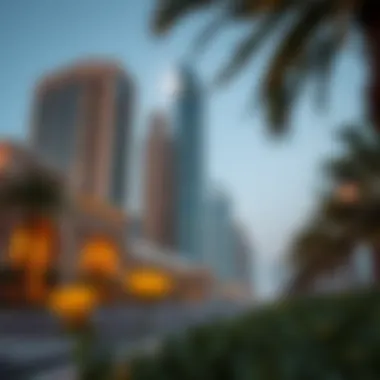
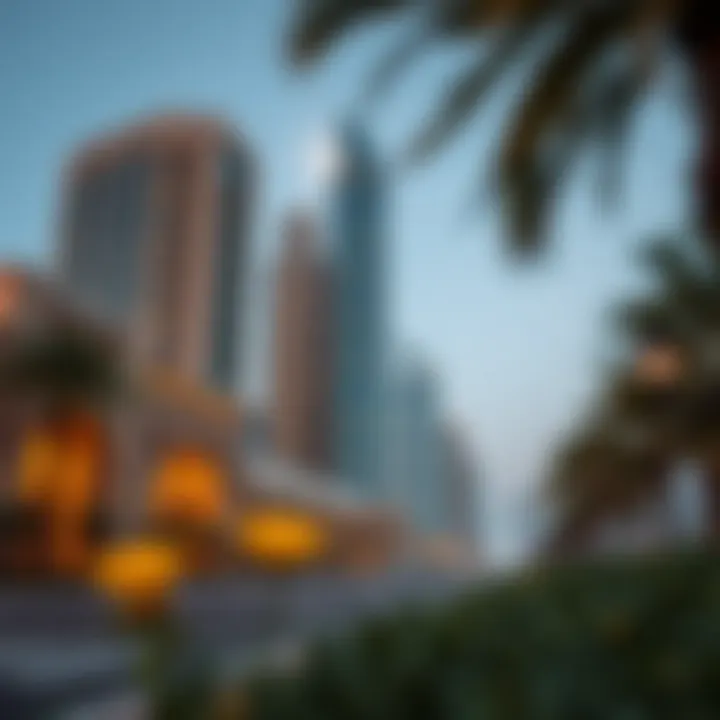
Modern Design Elements
The design of Etihad Towers is a modern interpretation of traditional Arabic architecture, combining sleek lines with contemporary materials. One of its standout features is the use of glass and steel, which gives it a striking appearance while reflecting the surrounding environment. This modern design approach not only appeals visually but also echoes the aspirations of a forward-thinking nation. However, this focus on modernity might alienate traditionalists who prefer classic architectural styles.
The Role of Towers in Real Estate
In the context of the United Arab Emirates, towers are more than just tall buildings; they embody the ambitions of a thriving real estate market. The significance of these structures in the property landscape cannot be understated. Towers influence urban dynamics, shape lifestyles, and offer a unique blend of residential and commercial opportunities.
Investment Opportunities
Residential vs. Commercial Towers
When choosing between residential and commercial towers, investors face essential decisions. Residential towers, often seen as family-friendly havens, provide a comfortable living space that can attract long-term tenants. Characteristics such as proximity to key amenities, like schools and shopping centers, enhance their appeal. On the other hand, commercial towers cater to businesses seeking office space, benefiting from high foot traffic and central locations.
For example, a striking feature of many residential towers is their luxury amenities—gyms, pools, and shared spaces that elevate living standards. This desire for lifestyle enhancement can lead to higher occupancy rates and stronger rental income. However, it is wise to consider that the commercial market can fluctuate with industry trends, creating opportunities and risks simultaneously.
Market Trends
Keeping an eye on market trends is paramount for savvy investors. The UAE real estate scene is dynamic, characterized by rapid shifts in demand shaped by economic factors and cultural changes. For instance, there's been a definitive move toward mixed-use developments, where residential units coexist with retail and entertainment spaces. This trend not only increases property value but also enhances community engagement, making it an attractive mainstream choice.
Additionally, the emergence of smart buildings and technology integration in these structures signals a shift in how real estate operates. Investors who adapt to these trends can capitalize on the growing demand for modern living environments that cater to a tech-savvy population.
Rental Market Insights
Demand Analysis
An accurate demand analysis is crucial in understanding the rental market within the UAE. Factors such as population growth, economic conditions, and expatriate influx significantly influence rental demand. In bustling cities like Dubai, where economic growth is consistently strong, demand ensures that properties stay desirable. The sheer volume of international businesses setting up shop in the region only adds to the need for residential and commercial spaces.
A significant characteristic of demand analysis is the fluctuation it may experience. While urban areas generally maintain high demand, economic downturns can lead to oversupply, impacting rental prices. Therefore, it’s essential for property managers to stay informed about market conditions to maximize their investment returns.
Rental Pricing Strategies
Crafting effective rental pricing strategies is an art that can make or break a property’s profitability. With an understanding of local market conditions, property managers must set competitive rates that resonate with potential tenants while ensuring profitability. Renters are often drawn to properties that provide a good value for their money.
A unique feature of these strategies includes seasonal variations. For instance, during peak seasons, landlords can adjust prices upwards due to higher demand. Yet, they must remain flexible and responsive to economic challenges or changing tenant needs. This adaptability can lead to long-term tenant retention, which is a cornerstone of successful rental operations.
"Real estate in the UAE is not merely a transaction; it’s a thriving ecosystem that continuously evolves."
In summary, the role of towers within real estate in the UAE centers around investment opportunities and market adaptability. A well-informed approach to investment and rental strategy can not only build wealth but also contribute significantly to the community's architectural and cultural landscape.
Innovation in Tower Construction
Innovation plays a crucial role in the evolution of tower construction in the UAE. As cities expand, so does the need for structures that not only stand tall but also incorporate advanced technology and sustainable practices. This section will delve into the specific elements that make innovation paramount in the architectural landscape of UAE towers.
Technological Advancements
Technological advancements have revolutionized tower construction. From sophisticated design software to cutting-edge materials, each stride in technology redefines what is possible. Tools like Building Information Modeling (BIM) enable architects to visualize projects in three dimensions before the first stone is laid. This practice minimizes the risk of costly mistakes and optimizes resource management.
Moreover, the integration of smart technologies has transformed buildings into dynamic entities. Consider the installation of intelligent systems that manage energy consumption and enhance comfort for occupants. For example, devices that adjust lighting and temperature based on personal preferences not only boost satisfaction but also lead to significant energy savings.
Key highlights of technological advancements include:
- Use of prefabricated materials that reduce on-site construction time.
- Advanced seismic engineering techniques that improve a tower's safety during earthquakes.
- Use of drone technology for site surveys, offering a bird's-eye view for better planning.
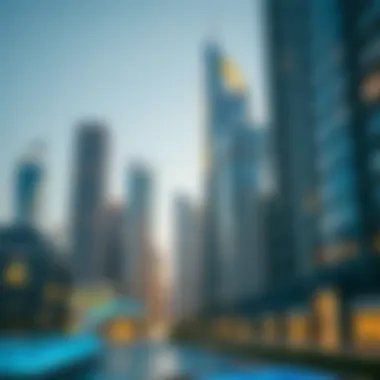
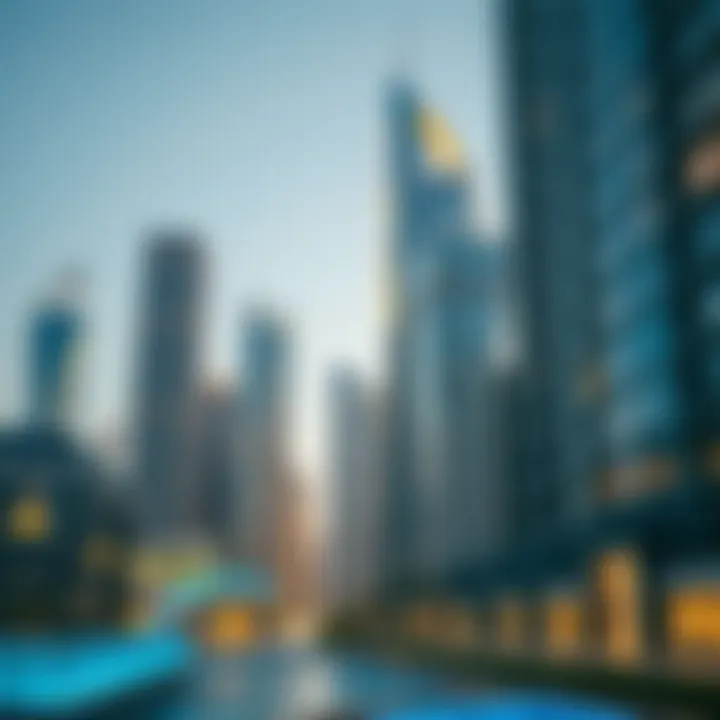
Sustainable Practices
Sustainable practices in tower construction are more than just a trend; they reflect a shift towards responsible building methods. In the UAE, where the climate poses challenges, integrating sustainability into tower design has become a necessity. Stylish structures are now built with materials that not only look good but are also environmentally responsible.
For instance, utilizing recyclable materials and implementing energy-efficient systems are just the tip of the iceberg. Towers like the Masdar City project in Abu Dhabi serve as prime examples of how innovative practices can make a structure's ecological footprint minimal.
To boost sustainability efforts, architects and builders consider the following aspects:
- Employing green roofs and vertical gardens that improve air quality and provide insulation.
- Utilizing solar panels to harness the abundant sunlight and reduce dependency on traditional power sources.
- Water recycling systems that lessen the demand on local resources and contribute to sustainability.
The future lies in our ability to embrace innovation—it's not merely about building taller but smarter and more responsibly.
Integration of technological advancements and sustainable practices paves the way for a new era in tower construction where the focus is on creating buildings that resonate with modern values while meeting the demands of a growing population.
As we look ahead, the combination of these innovations sets the foundation for even greater developments in UAE's architectural marvels.
The Future of UAE Towers
The future looks bright for the towers of the UAE. As cities grow and evolve, their skylines must reflect modern needs and aspirations. This section explores the emerging pathways that are expected to shape the next phase of architectural marvels. From smart technology integration to a commitment towards sustainability, the innovations in tower construction will not only change the appearance of these structures but also their functionality and impact on urban lifestyles.
Emerging Trends
Smart Buildings
In today’s tech-driven world, Smart Buildings have begun to reshape the architectural landscape. These structures are designed to improve the quality of life for residents through advanced technology. A key characteristic of Smart Buildings is their ability to integrate artificial intelligence and automation to manage various building systems more efficiently. This not only makes them energy-efficient but also adds a layer of convenience.
Smart technology enables real-time data collection, giving property managers insights into maintenance needs and energy usage. For instance, automated systems can adjust lighting and temperature based on occupancy, which ultimately reduces energy waste. Some might say it’s like having an automatic housekeeper, ensuring every corner runs like a well-oiled machine.
However, while Smart Buildings present numerous advantages, they do come with disadvantages. High initial costs for installation and potential technical issues can deter some investors. Therefore, it’s vital to weigh these factors when considering investments in this domain. Ultimately, the long-term benefits may outweigh the hurdles, making them a popular choice for modern real estate developments in the UAE.
Green Architecture
Green Architecture is another trend gaining traction in the UAE, where the focus on sustainability is becoming increasingly critical. The key characteristic of this approach is its emphasis on eco-friendly materials and energy-efficient designs. By minimizing environmental impact, green buildings promote better quality living and reduce operational costs over time.
A unique feature of Green Architecture is its use of renewable energy sources, like solar panels. Incorporating these elements not only leads to energy savings but also enhances the building’s appeal to environmentally conscious buyers and renters. It’s akin to planting a seed for the future—ensuring that the buildings of tomorrow don’t just meet present needs but also safeguard the environment for generations to come.
On the downside, constructing green buildings can sometimes demand higher upfront investments. Still, these costs are often recouped through long-term savings, including lower utility bills and increased property value. As awareness around climate change grows, more developers are investing in green technologies, which could ultimately reshape the skyline of urban UAE.
Global Influence
The UAE towers are not only a testament to local ambitions but also reflect global architectural trends. They contribute significantly to a worldwide conversation about sustainability and smart technologies. As these towers evolve, they may influence architectural practices across continents, showcasing how modern cities can develop in harmony with nature and technology. Cities around the world are observing the UAE's strides—often looking for inspiration on how to tackle urban challenges within their unique contexts.
Ending
In wrapping up this exploration of the architectural marvels that populate the UAE skyline, it's important to reflect on the leading elements that underscore the significance of towers in this region. The towers not only redefine the urban landscape but also embody the fusion of innovation, culture, and commerce that characterizes contemporary Emirati society. These towering structures stand as beacons of modernity, their silhouettes etched against the extensive desert horizon, inviting further investigation into their multifaceted implications.
Summary of Insights
As highlighted in previous sections, the towers of the UAE serve various pivotal functions:
- Cultural Icons: Each tower pulses with the regional narrative, showcasing the UAE's rich heritage while simultaneously embracing global architectural trends.
- Real Estate Boon: Investment opportunities abound, driven by a robust demand for both residential and commercial spaces. Towers play a vital role in shaping urban living, appealing not just to homeowners but to investors eager to tap into this thriving market.
- Sustainable Innovations: The advance of eco-friendly initiatives and smart technologies highlights a commitment to future challenges, ensuring that these structures remain relevant in a quickly evolving world.
In summary, each architectural endeavor reflects the aspirations of a nation that is continuously pushing the boundaries of innovation and urban development.
Final Thoughts
"In the UAE, every tower tells a story, not just of its aesthetic value but also of the people, their lifestyles and aspirations behind it."
As these impressive structures continue to evolve, they will undoubtedly play an instrumental role in both enhancing the urban experience and providing a catalyst for further investments in the region. The future of UAE towers is not just about reaching new heights; it’s about elevating the lifestyle and ambitions of all who call this remarkable region home.















